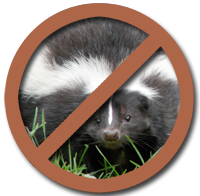
How to keep skunks away
Like any wild animal, the skunk is attracted to an area because of a food source.
Cat/dog food left outside is a meal. If you have a skunk living under your house the
first thing you can do is take away the food that drew them there to begin with.
Scatter mothballs under the house and half way bury a bottle filled with bleach and a
rag in the dirt. Skunks have very sensitive noses and the fumes from both of these should
make it leave. Put flour around the entrance, check the direction of the paw prints and
close up when the skunk is gone. Another skunk repellent is made up of:
- 8 ounces of dish detergent
- 8 ounces of castor oil
- 1 gallon of water
Additional Articles about skunks
Animal Information
Striped Skunk
Description
The striped skunk is a small animal about the size of an average house cat.
Its distinctive white stripe that extends from its forehead, down its back,
to the tip of its bushy tail serves as a warning to predators. Its scent glands
are well developed and the skunk may emit a strong spray of musk if feet stomping
or tail arching does not scare off an attacker. They can spray with amazing accuracy
(up to 13 ft).
Benefits
While the disadvantage of having a skunk nearby is obvious (to the nose at least).
This creature is beneficial — preying on small vermin such as mice.
Skunks can catch mice in very hard-to-access places. In addition, skunks are
rather mellow. They do not usually spray unless really scared or cornered.
Habitat
The striped skunk lives in a variety of semi-open country: mixed woods, brushland,
and open prairie; especially in the vicinity of rivers and ponds. Skunks sometimes
use abandoned burrows of other animals as a den, dig its own, or it might den in
woodpiles or abandoned buildings. It may also seek shelter or temporary living quarters
in the spaces under a house or deck. Rarely does a skunk family that has denned under
someone’s house stay for very long.
Habits
Skunks are nocturnal animals, meaning they are active mainly at night, although they
are sometimes seen during the day. Young skunks are more often seen foraging or playing
during the day than are the adults, except during late winter when it is breeding time.
They do not hibernate although they may be inactive for weeks during the winter. The
males are solitary while the females may den together in the winter.
Skunks are also nomadic, and they do not take up permanent residence under buildings or in your shed. Given time they will move along all on their own.
"The Warning"
Folks living in the country may have noticed that dogs are sprayed by skunks much more
often than humans. There is a good reason for this. If you do manage to get a skunk
"ticked off" at you — it will stamp it's front feet as a last warning. If you stop and
back off, so will the skunk. Dogs do not understand the warning and charge ahead.
Diet
Skunks eat a variety of foods. They are very helpful animals in that they feed abundantly
on insects. Their diets also include berries, mice, frogs, eggs and assorted vegetable
matter. They are also known to eat yellow jackets and their nests, leaving large holes
in the ground. The skunk itself is food for great horned owls and golden eagles.
Common Misconceptions — Rabies
It is not true that all skunks have rabies. Skunks are no more likely to contract
rabies than other animals, wild or domestic. In fact, you are far more likely to be
hit by lightning, or win the lottery, than contract rabies from a skunk. Since 1980,
only one recorded death has been attributed to skunk-related rabies. A healthy skunk
cannot “carry” rabies and pass it on. Only sick, rabid animals can transmit rabies and
the transmission is through saliva, it is not an airborne virus. In saying this, we do
NOT recommend you be careless handling skunks or any wild animal. Leave the hands-on work
to the professionals.
For self-help information on skunks click on Self-Help: Skunks
Return to Animal Information Page